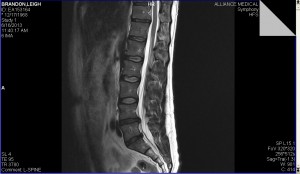I n part one of this post, I gave an update on my progress since prolapsing two discs in my lumbar spine in June 2013. I also highlighted what I have done to help rehabilitate the discs.
n part one of this post, I gave an update on my progress since prolapsing two discs in my lumbar spine in June 2013. I also highlighted what I have done to help rehabilitate the discs.
In this post, I will describe what I think were the causes of my prolapsed discs. If I had a pound every time time someone asked me what caused the discs to prolapse I would be a very rich man!!!
So what caused my discs to prolapse?
I don’t think there was any one thing that caused my discs to prolapse and I certainly didn’t have any trauma such as a road traffic or sporting accident prior to the pain. Indeed, the first symptoms of back and leg pain were experienced as I woke up one morning.
Like most injuries, the damage to the tissues (in this instance the lumbar discs) occur slowly over time. One incident might seem like it causes the injury, but often times it is merely the straw that broke the camels back.
One thing I feel might have contributed to micro-trauma of the discs is that I have had a restricted right ankle for some time. My right ankle is unable to dorsiflex (flex the foot and toes upward) anywhere near as much as the left ankle. This might be due to years of playing football which can lead to a bony growth in the ankle joint of the dominant kicking leg , which prevents a full range of motion.
A restriction in ankle dorsiflexion often leads to a weight-shift during Squatting (and I do a lot of Squatting in the gym) away from the restricted side. The pelvis shifts away from the restricted side under load which can easily place excessive stress and strain on the discs. In my case, my right ankle is restricted and the damage to the discs was on the left side, so this seems logical.
In addition, I have been playing tennis regularly since 2003. When I serve as a right-handed tennis player, the spine flexes and rotates to the left. Flexion and rotation puts a high level of stress on the annulus fibrosis (the outer layers) of the discs. Again, the fact that my discs were damaged on the left side suggests that serving in tennis over many years could have contributed to the micro-trauma of the discs.
Also, the two years leading up to the onset of symptoms I had been writing a book and a training course on Tennis Conditioning for The CHEK Institute. This meant that I was sitting for very long hours each day reading research papers, writing content and searching for stock photographs. Sitting for long periods, I’m sure I would have sat with my lower back flattened, which would also put stress on the discs and stretch the supraspinous ligaments, which help to support the spine.
For 18 months prior to the onset of symptoms I was also taking Bikram Yoga classes. Bikram Yoga is performed in a room at 41° C. The class is 90-minutes in length and the heat allows your body to move and stretch further than it would in a normal temperature. As much as I really enjoyed the classes and felt amazing afterwards, I would often notice that I could feel my discs moving in and out of place during 2 or 3 of the asanas (postures). With hindsight, I realised that it probably was damaging my discs, which was a very good lesson to listen to what my body is telling me and act on it.
The final contributing factor to the prolapsed discs was my level of fatigue. I had been working very hard to write the book and course as well as a gruelling teaching and presenting schedule and running my business BodyCHEK helping clients to turn there life around by helping them overcome illness, pain and optimising their health and fitness. When the body is chronically fatigued, the adrenal glands create an inhibitory affect on the psoas muscle in an attempt to cause the person to slow down and take some rest. This occurs because when the psoas muscle become weak or flacid, it contributes to flat lumbar spine, which again puts more stress on the discs and supraspinous ligaments, increasing the likelihood of injury.
Perhaps the pain was my body’s way of telling me I needed to slow down, work less and rest more?
So what caused my discs to prolapse? Micro-trauma over many years caused by a combination of a restricted right ankle, serving a tennis ball several thousand times, a lot of time spent seated and chronic fatigue. The straw that broke the camels back might have been the heavy Deadlifts I performed two days before the onset of symptoms.
As you can see from the above, the causes of injuries can be complex. It is always imperative to find the causes of an injury otherwise a long term solution is very unlikely. This is why as CHEK Practitioners, we are trained to find the causes of symptoms with very thorough assessment processes, not just treat the bit that hurts.
Until next time…
